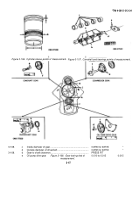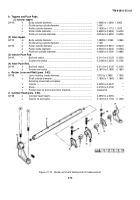TM-9-2815-213-34 - Page 91 of 192
C2,
TM 9-2815-213-34
Thereafter,
check oil level of the engine,
with the
dipstick every two (2) hours during run-in test.
Maintain
oil level at "H" mark on the dipstick.
(5)
Check engine coolant as follows:
(a)
After engine is started,
add coolant as
required to completely fill cooling system and replace
entrapped air.
(b)
The ideal water temperature is 175
degrees Fahrenheit for best engine performance.
It
should ] exceed 190 degrees Fahrenheit during
operation.
(c)
Do not turn off engine immediately after
load operation.
Heat stored in the iron masses will boil
cooling water in the jackets if air and water circulation
cease while engine is still hot.
Allow engine to idle for a
few minutes before shutting down.
(6)
Check fuel pressures as follows.
(a)
Check fuel manifold pressure with f
system pressure gage (4,
fig.
B-29) as shown figure 3-
99.
Accelerate from idle to full throttle a record
maximum pressure recorded on gage; it should be 202
to 218 pounds.
(b)
Check fuel rate with fuel flow rate check
gage (2,
fig.
B-24) as shown in figure 3-100.1 gage’s
flow tank is placed between the engine and t fuel supply
tank.
Fuel return line(s) and the f pump suction line are
then attached to the circulating tank.
NOTE
As the engine burns fuel,
the float valve
allows make-up fuel to flow into the cir-
culating tank from the fuel supply tank.
This make-up fuel passes through the
flowmeter and is the fuel rate of the
engine registered in pounds per hour.
Fuel rate is 120 pounds per hour.
(c)
Accelerate engine from idle to full
throttle and check manifold pressure with Pressure
Gage.
It should be 202 to 218 pounds.
(d)
Refer to Section XIX Fuel Pump for fuel
pump governor adjustments.
(e)
Inspect all fuel lines and connections for
leaks and security of mounting.
(f)
Inspect lubricating oil connections for
leaks.
Check oil cooler for security of mounting and in-
let/outlet connections for leaks.
(g)
After run-in has been completed,
load
applications should be minimal for the first 50 hours of
operation.
This gives new parts a chance to "wear- in"
without undue stress and strain.
3-173.
Performance Curve
Figure 3-101 is an engine performance curve.
Solid
lines represent maximum ratings at 500 feet altitude
29.38 inches mercury and 85 degrees Fahrenheit
ambient air temperature.
The dotted lines indicate
standard sea level conditions.
These curves indicate
engine performance with fuel system,
water pump,
lubricating oil pump and air cleaner.
It does not include
battery charging generator,
compressor,
fan and
optional equipment.
Section XXXIII.
REPAIR AND REBUILD STANDARDS
3-174.
General
The repair and rebuild standards give maximum
minimum,
and key clearances of new or rebuilt pa Wear
limits are given,
which indicate the point which a part or
parts may be worn,
in order to receive maximum service
before replacement.
Normally,
parts which have not
been worn beyond the dimensions shown in "Wear
Limits" column will be
proved for further service.
An asterisk in the "Wear
Limits" column indicates that the part or parts should be
replaced when worn beyond the limits given in the "New
Dimensions" column.
All dimensions are given in inches.
3-175.
Cylinder Block
(para 3-4)
3-62
Back to Top




















